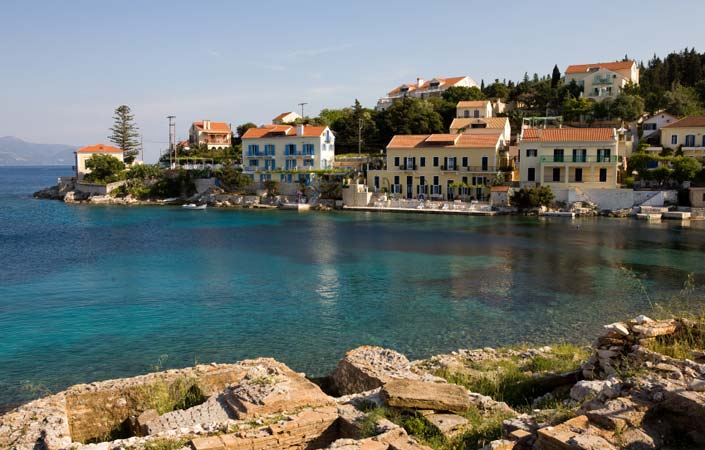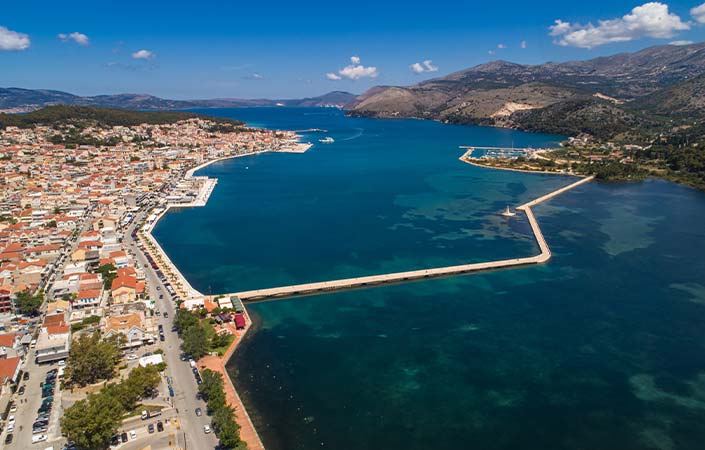Kefalonia
The bigger island of the Ionian Sea. Its nature is a pleasant surprise to the thousand of visitors that come to the island every year. The natural caverns, the curious rocks, the strange beaches, the green hills, the beautiful lakes, fascinate the visitors. Kefalonia is an ideal place for those who want to rest and for those who love to explore the nature.
The residents are distinguished for their hospitality, their cleverness, their humour and the choral songs. They are people who managed to spread around the world, distinguish and get rich.
According to a legend Kefalonia took its name from Kefalos who turned away Tilevoes, while Homer called it Sami and the residents Kefallines, a name attributed generally to the citizens of Odysseus. Kefalonia flourished during the Mycenaean period and later in the 5th century B.C. with the Kefalinian “tetrapolis” which constituted of four cities-states, Pali, Krani, Proni and Sami after the names of Kefalos sons. Wars force the residents to fortify the island with walls and castles. During the Roman occupation and the Byzantine period the island decays. Various conquerors follow like Normans, Venetians (an era characterized by intense economic and cultural growth), French, Turks, English and finally in 1864 Kefalonia is united with the remainder Ionian islands with Greece.
All conquerors left their marks and contributed to the creation of the particular Eptanisian culture, with traditions, customs, songs, dances and linguistic idioms that we do not meet in other parts of Greece.
Kefalonia is the island of N. Kavadias, Marinos Antypas, Andreas Laskaratos and innumerable other old and modern leading poets, litterateurs, musicians, painters and in general as they are characteristically called “uneasy spirits”.
Sights
- National Park of Mount Aenos (altitude 1620m). Established in 1960, for the protection of the unique dark green fir. On the slopes lives a rare breed of wild horses.
- Katavothres – Argostoli. Here the sea waters enter natural holes, follow an underground route and reappear days later to Karavomylos lake in Sami at the other end of the island.
- Drapanos Bridge – Argostoli. Constructed in 1813 form the English and connects Argostoli with Drapano shore.
- the Lighthouse of St Theodoron in Fanari area.
- Monument for the Italian soldiers of the Acqui army division. Dedicated to the Italian soldiers massacred by the Germans durig the 2nd World War.
- Asos Fortress. A Venetian castle of the 16th century at the top of the peninsula in an area covered with cypress trees and pines and a great view.
- St. George Castle. 16th century Venetian castle that used to be the capital of Cephalonia.
- Lake-cave Melissani – Karavomylos. Part of the roof of the cave has collapsed so that the sun rays enter the cave and in combination with waters make a magnificent sight. The waters flow to the nearby Karavomylos lake One can visit the cave by boat.
- Drogarati Cave. An impressive cave with stalactites and stalagmites. The cave has artificial lighting that creates a magnificent view. Due to its great acoustics it is used for concerts.
- St Gerasimos Cave, where the saint lead an ascetic life.
- Archaeological area of Krani
- Archaeological area of Sami
- Mycenaean Tombs – Mazarakata.
- Roman villa – Skala. Ruins of a Roman villa of the 3rd century A.D with well preserved mosaics and signs.
- Vaulted Tomb – Tzanata. The findings show the existence of a significant Mycenaean center.
- Monastery of Virgin Mary at Koronato.
- Monastery of Virgin Mary – Paleoherso.
- St. Gerasimos Monastery, protector of the island – Omala
- Church of Virgin Mary Lagouvarda –Markopoulo. On August 15th every year appear Virgin Mary’s snakes.
- St. Andreas Monastery – Milapidia.
- Iakovatios Library – Lixouri. Housed in a neoclassic mansion the library includes a rich collection of old books, manuscripts and icons.
- Korgialenios Library – Historical and Folk art Museum – Argostoli.
- Archaeological Museum – Argostoli, with findings form excavations in the island and a section with exhibits from the Mycenaean period.
- Ecclesiastic Museum in St. Andreas Monastery – Peratata.
Information
Access-Transportation
By Plane
Kefalonia airport 0030 26710 29900
By Ship
From Patra, Kyllini and Astako
Kefalonia port authority 0030 26710 22224
Kefalonia port authority Poros 0030 26740 72460
Kefalonia port authority Sami 0030 26740 22031
Kyllini port authority 0030 26230 92211
Patra port authority 0030 2613 615400
Astakos port authority 0030 26460 41052
By Bus
From Athens and Patra
Kefalonia KTEL (Public Bus Service)
http://www.ktelkefalonias.gr
0030 26710 22281
Athens KTEL (Public Bus Service) – Kifisos station
0030 210 5150785
Useful
Area: 734 sq km
Capital: Argostoli
Kefalonia prefecture administratively belongs to the Region of Ionian Islands and consists of Kefalonia and Ithaca municipalities.

